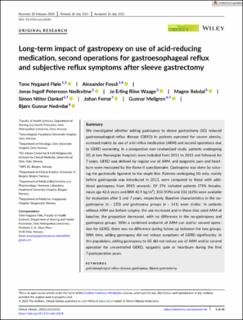Long-term impact of gastropexy on use of acid-reducing medication, second operations for gastroesophageal reflux and subjective reflux symptoms after sleeve gastrectomy
| dc.contributor.author | Flølo, Tone Nygaard | |
| dc.contributor.author | Fosså, Alexander | |
| dc.contributor.author | Nedkvitne, Jonas Ingolf Petersson | |
| dc.contributor.author | Waage, Jo Erling Riise | |
| dc.contributor.author | Rekdal, Magne | |
| dc.contributor.author | Dankel, Simon N | |
| dc.contributor.author | Fernø, Johan | |
| dc.contributor.author | Mellgren, Gunnar | |
| dc.contributor.author | Nedrebø, Bjørn Gunnar | |
| dc.date.accessioned | 2024-01-24T07:50:57Z | |
| dc.date.available | 2024-01-24T07:50:57Z | |
| dc.date.created | 2023-10-06T12:16:39Z | |
| dc.date.issued | 2023 | |
| dc.identifier.citation | Clinical Obesity. 2023, 13 (5), . | en_US |
| dc.identifier.issn | 1758-8103 | |
| dc.identifier.uri | https://hdl.handle.net/11250/3113449 | |
| dc.description.abstract | We investigated whether adding gastropexy to sleeve gastrectomy (SG) reduced gastroesophageal reflux disease (GERD) in patients operated for severe obesity, assessed mainly by use of anti-reflux medication (ARM) and second operations due to GERD worsening. In a prospective non-randomized study, patients undergoing SG at two Norwegian hospitals were included from 2011 to 2015 and followed for 7 years. GERD was defined by regular use of ARM, and epigastric pain and heart- burn were measured by the Rome II questionnaire. Gastropexy was done by sutur- ing the gastrocolic ligament to the staple line. Patients undergoing SG only, mainly before gastropexia was introduced in 2013, were compared to those with addi- tional gastropexy from 2013 onwards. Of 376 included patients (75% females, mean age 42.6 years and BMI 42.9 kg/m2), 350 (93%) and 232 (62%) were available for evaluation after 1 and 7 years, respectively. Baseline characteristics in the no- gastropexy (n = 235) and gastropexy groups (n = 141) were similar. In patients without ARM use before surgery, the use increased and in those that used ARM at baseline, the proportion decreased, with no difference in the no-gastropexy and gastropexy groups. With a combined endpoint of ARM use and/or second opera- tion for GERD, there was no difference during follow-up between the two groups. With time, adding gastropexy did not reduce symptoms of GERD significantly. In this population, adding gastropexy to SG did not reduce use of ARM and/or second operation for uncontrolled GERD, epigastric pain or heartburn during the first 7 postoperative years. | en_US |
| dc.language.iso | eng | en_US |
| dc.rights | Navngivelse 4.0 Internasjonal | * |
| dc.rights.uri | http://creativecommons.org/licenses/by/4.0/deed.no | * |
| dc.title | Long-term impact of gastropexy on use of acid-reducing medication, second operations for gastroesophageal reflux and subjective reflux symptoms after sleeve gastrectomy | en_US |
| dc.type | Peer reviewed | en_US |
| dc.type | Journal article | en_US |
| dc.description.version | publishedVersion | en_US |
| cristin.ispublished | true | |
| cristin.fulltext | original | |
| cristin.qualitycode | 1 | |
| dc.identifier.doi | 10.1111/cob.12618 | |
| dc.identifier.cristin | 2182416 | |
| dc.source.journal | Clinical Obesity | en_US |
| dc.source.volume | 13 | en_US |
| dc.source.issue | 5 | en_US |
| dc.source.pagenumber | 0 | en_US |
Tilhørende fil(er)
Denne innførselen finnes i følgende samling(er)
-
HV - Institutt for sykepleie og helsefremmende arbeid [1400]
HV - Department of Nursing and Health Promotion -
Publikasjoner fra Cristin [3269]

